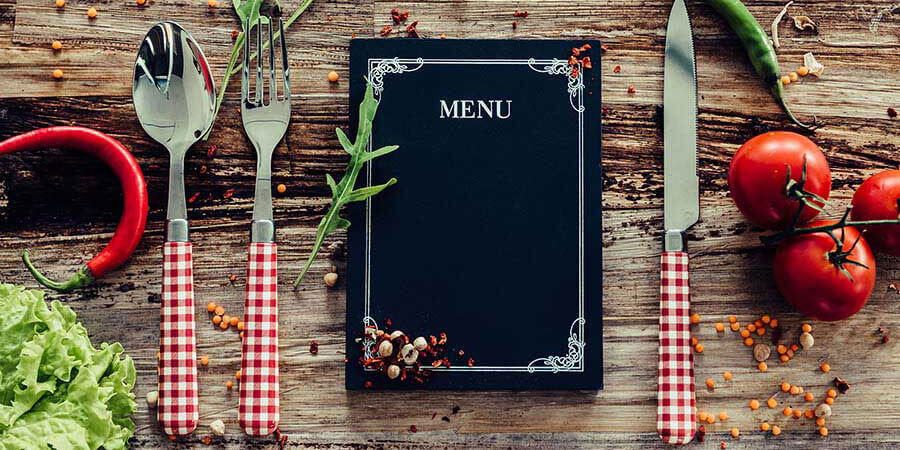4 Steps to Create the Perfect Restaurant Menu

There’s more to creating a delicious, unique, and cost-effective restaurant menu than meets the eye — literally! While menu design is, of course, important, many dynamic elements go into menu planning. Here’s how to craft a menu that will have guests “oohing” and “ahhing” in no time!
What is Restaurant Menu Preparation?
Restaurant menu preparation is the process of strategically planning your menu in keeping with various aspects of your food outlet. It has to do with more than just the culinary side, affecting everything from branding impact to customer experience. Here are some dimensions of menu prep:
- What type of restaurant will you be opening? What kind of cuisine(s) will you offer?
- How will you present the menu? What information will you provide for context? What tone will you use?
- How does that all fit in with your branding?
- How will you break up your menu, section by section?
- How will you price out your menu to maintain solvency and make a profit ?
How to Craft the Perfect Restaurant Menu in Just 4 Steps
1. Develop Your Concept
The first step in creating a mouth-watering menu that customers will go ga-ga over is to definitively and concretely spell out your concept. In other words, what kind of restaurant are you trying to open?
Work backwards from there to determine whether your menu should include one type of cuisine, or a mix of items, whether you’ll be serving just appetizers or just sandwiches, or a full five-course meal.
Here are two important questions to ask yourself during this process, according to Johnson & Wales University:
- How many menu items should you have?
- Who is your target customer?
2. Dial Down on Flavor & Ingredients
List all the ingredients you’ll need for each dish. Figure out how you’re going to source them, and if doing so is both feasible and affordable throughout the year.
Next, cook everything on your menu and conduct taste tests — both internally and via public tasting events.
The goal for this step is to create a menu that’s broad enough to provide variety to your customers but narrow enough to keep your profit margins sufficiently high, all the while sourcing ingredients that are easy to come by.
And of course, you want to make your menu irresistibly delicious...But you knew that already.
3. Write & Design Your Menu
Once you’ve decided on what you’ll be including o n your menu, you’ll have to decide h ow you’re going to present it to your customers.
In other words, in this step, you will be writing your menu titles and deciding what’s important to include in menu item descriptions (i.e. main ingredients, common allergens, heat levels, calorie count).
This step also involves carefully considering how to break up your menu into different sections and designing the aesthetics of your menu (choosing font type, size, colors, images , and more ).
Looking for restaurant menu design templates? Most restaurant management software providers offer them, but you can also find customizable menu design templates through organizations that provide UX and design services including Microsoft and Adobe.

4. Price Out Your Menu
You’re opening a restaurant because you’re creative and have a culinary vision, sure. But you also want to make money and stay in business. So think carefully about your pricing strategy and do the math.
Johnson & Wales suggests keeping your food cost percentage to no more than 25% to 35% of the total price of the menu item. Here’s how to calculate your food cost percentages and devise sustainable menu pricing:
“You can arrive at your menu price by dividing the cost of the ingredients by your target food cost percentage. For example, suppose the cost of the ingredients in an item is $6.00, and you’ve chosen 25% as your food cost percentage. In that case, you divide $6.00 by 25% to arrive at your menu price ($24.00).”
What Makes a Good Menu?
Taking a step back from the process of how to make a restaurant menu, let’s consider the larger question, what makes a good menu?
Toast offers several suggestions to answer this question from a menu design perspective. According to them, a good menu is designed to:
- Consider eye movement patterns & place high-margin dishes at the top left, top right, and center.
- Offer enough white space to reduce clutter and improve aesthetics.
- Use boxes and colors to provide visual cues.
- Promote spending (so leave out the dollar signs and avoid stacking prices in a single column).
- Decrease option overload (so keep a carefully curated menu...shorter is better than longer).
- Use photos and/or descriptive adjectives like “buttery”, “crisp” and “savory” to communicate what the dish is and how it will taste.
As we’ve discussed in our blog post “Catering Menu Ideas”, checking out what your competitors a redoing with their menus can provide guidance when deciding on what the best restaurant menu design is for your establishment.
Final Thoughts
Once you’ve designed your menu after some time has passed and you get a chance to observe what’s working and what isn’t, don’t stop there. Instead, reevaluate your margins and take a look at your best-sellers vs. laggards . After all, while certain menu items will keep customers coming back time and time again, very few restaurants are successful for years with a stagnant menu.
Be sure to think about your menu in terms of your food preparation capabilities as well. For instance, do you have a deep fryer if you’re planning to include homemade french fries as a side for various entrees?
Go Foodservice can equip you with the high-quality commercial restaurant equipment you need to turn your menu ideas into a daily reality.
Share This!